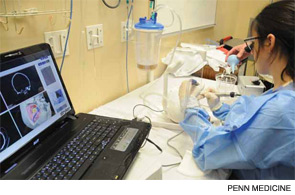Christine Franzese, MD, FAAOA, associate professor and residency program director of otolaryngology and communicative sciences at the University of Mississippi Medical Center in Jackson, and co-creator and immediate past chair of the Society of University Otolaryngologists-Otolaryngology Program Directors Organization (SUO-OPDO), said the combination of duty-hour restrictions on first-year residents and potential reductions in federal funding may spur discussions about how to tweak residency training. Those conversations will likely include whether otolaryngology training should be reduced to four years from five. "If that happens, simulation becomes an extremely efficient way to train a resident," she said.
Explore This Issue
August 2011The benefits of simulation as a training tool are not limited to just procedures and techniques. Otolaryngologists also believe role-play scenarios can help teach teamwork, cooperation and bedside manner. Standardized patients, specially-trained people skilled in both play-acting a medical malady and assessing a resident’s reaction, can even portray family members to give young physicians practice in dealing with non-clinical discussions.
Among the best advantages is the use of simulation as a post-event educational session. Dr. Deutsch said the so-called debriefing allows for review of a range of issues, from technical care (Was the procedure performed well?) to medical management (Did the resident prescribe the right medication and in the right dose?) to personal approach (How well did participants communicate with others?).
"While you can debrief after clinical experiences, oftentimes, the practical necessities of needing to address the next patient concern that’s on your list makes that difficult," Dr. Deutsch said. "But with simulation, debriefing is usually budgeted in to the time allotment so that it becomes part of the exercise. That’s a very important part of the learning process."

Cost-Benefit Analysis
The potential of simulation may be boundless, but the ability for teaching hospitals to pay for and implement the approach is not. And those are just two of the challenges that will arise as simulation becomes more and more popular.
"My institution is not buying a $250,000 simulator for ENT," Dr. Malekzadeh said. "It’s just unrealistic. … [Simulation programs] are proving that they’re valuable in terms of attaining proficiency, and now we’re starting to see the transfer of skills to the operating room, but it’s the availability of those products."
Kelly Malloy, MD, assistant professor of otorhinolaryngology-head and neck surgery at the Hospital of the University of Pennsylvania in Philadelphia, said another limitation of simulation is at the top end of training. Simulators cannot yet help prepare otolaryngologists for all complex treatments.
Leave a Reply